This post may contain affiliate links. Please read our disclosure policy. As an Amazon Associate, I earn from qualifying purchases.
This rustic sourdough bread bakes up with a crisp, blistered crust and a chewy, open crumb. No fancy techniques required. A long, slow fermentation builds complex, well-developed flavor, while the Dutch oven traps steam for that golden artisan finish. With just four ingredients and a little planning, you’ll get a loaf that looks and tastes like it came from a bakery
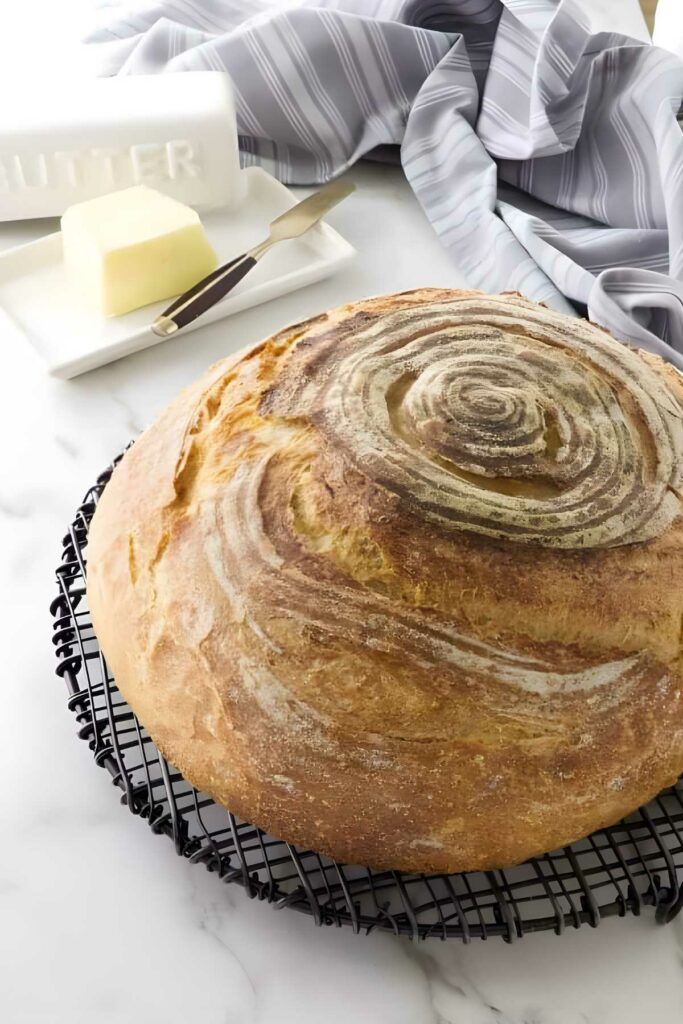
Looking for a version made with ancient grains? Try our Einkorn Sourdough Bread for a nutty, flavorful twist.
Here’s Why This Sourdough Bread Recipe Works
A Dutch oven creates its own steam chamber, helping the loaf rise fully and develop a crisp, crackling crust.
Long fermentation builds better flavor. A slow rise (especially overnight) develops complexity without pushing the dough into sharp sourness.
Sticky dough makes great bread. This high-hydration dough can be a little messy, but it’s worth it. The extra moisture helps create an open, chewy crumb.
Stretch and fold, or knead if you prefer. A few quick folds during the first rise are all it takes to build structure. But if you’re more comfortable with traditional kneading, we’ve included notes for that method too.
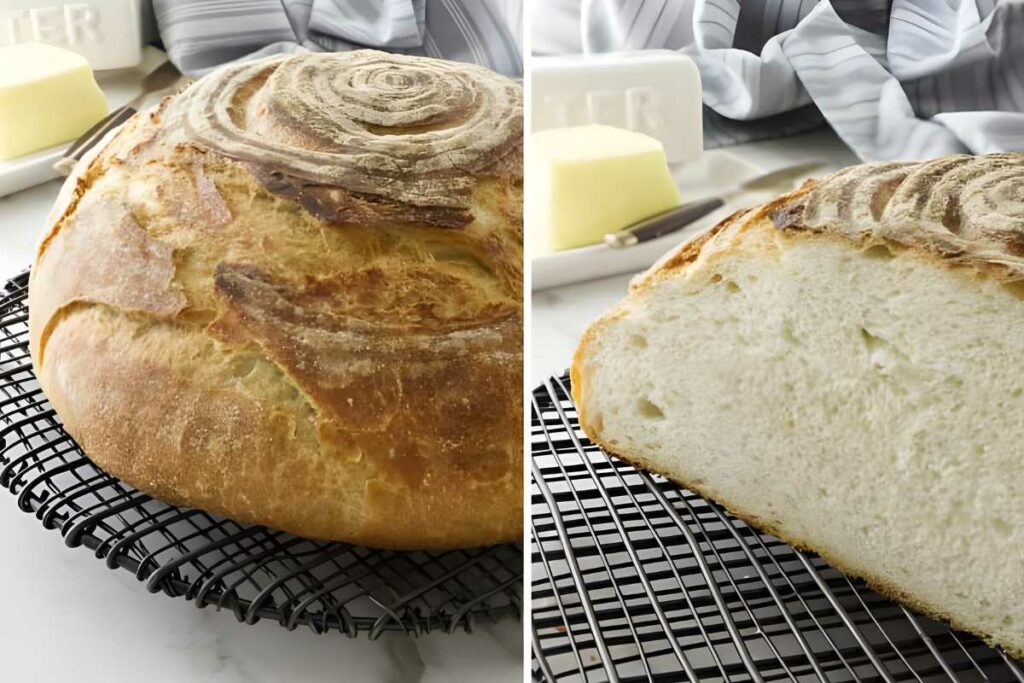
For a sweeter way to use your sourdough starter, these Sourdough Raised Donuts are soft, pillowy, and downright irresistible.
Recipe Tips
Weigh your ingredients. Measuring flour by volume can swing wildly. Using a scale keeps your hydration consistent and your dough predictable.
Handle sticky dough with wet hands. This dough is higher in hydration and a bit sticky. A quick splash of water on your hands makes shaping easier.
Dust proofing baskets with a rice flour blend. All-purpose flour tends to stick. A 50/50 mix of rice and AP flour creates a drier surface that helps the dough release cleanly.
Preheat your Dutch oven. You can bake in a cold pot, but a fully preheated Dutch oven gives you better oven spring and a more dramatic rise.
Watch the dough, not the clock. Rising times vary with temperature and starter strength. Instead of timing it strictly, look for dough that’s puffy and slightly jiggly before baking.
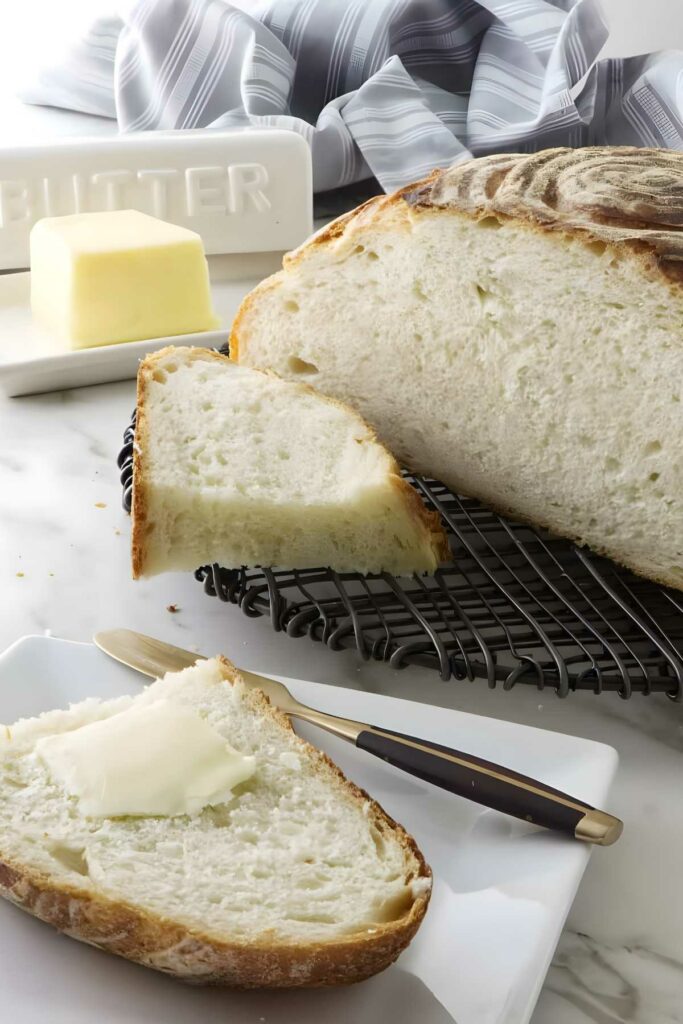
Rustic Sourdough Bread
This is the kind of bread that reminds you why baking from scratch is worth it.
The crust sings, the crumb is open and chewy, and the flavor runs deep. You don’t need fancy tools or a complicated routine, just patience, good ingredients, and a Dutch oven.
Pin this now to find it later!
Pin It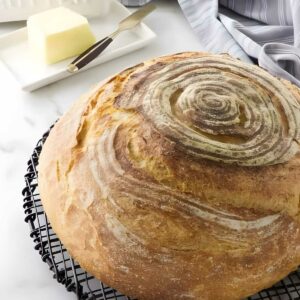
Easy Sourdough Bread Recipe
If you make this recipe, please leave a star rating and comment.
Ingredients
- ⅔ cup active sourdough starter, (160 grams)
- 1⅓ cups warm water, (314 grams)
- 4¼ cups all-purpose flour, (510 grams)
- 2 teaspoons salt, (12 grams)
Instructions
Mix the dough
- In a large bowl, combine the sourdough starter, warm water, flour, and salt. Stir with a spatula or your hands until no dry spots remain. The dough will be sticky and shaggy. Cover the bowl with a damp towel or plastic wrap and let it rest for 30–45 minutes.
Stretch and fold and Bulk Rise
- After the rest, perform the first stretch and fold: with wet hands, grab one side of the dough, stretch it upward, and fold it over the center. Rotate the bowl and repeat 3 more times for a total of 4 folds.
- Repeat this process 2 more times, spaced 30 minutes apart, for a total of 3 rounds. After the final fold, cover the bowl and let the dough rise at room temperature until puffy and nearly doubled in size, about 4 to 6 hours, depending on the temperature.
Shape and proof
- Turn the dough out onto a lightly floured surface. Gently shape it into a round by folding the edges toward the center and flipping it over. Use your hands or a bench scraper to tighten the shape slightly.
- Place the dough seam-side up in a floured proofing basket or towel-lined bowl. Cover and refrigerate for 8 to 12 hours for a cold fermentation that develops more flavor and makes scoring easier.Short on time? You can skip the fridge and let the shaped dough rise at room temperature for 1 to 3 hours, or until it looks slightly puffy and airy. See the note below about signs that the bread is ready to bake.
Score and bake
- Place a Dutch oven with the lid on into the oven and preheat to 475°F. Let it heat for at least 30 minutes to ensure the pot is thoroughly hot.
- Remove the dough from the fridge and invert it onto a sheet of parchment paper. Score the top with a sharp knife or lame.
- Carefully transfer the dough (on the parchment) into the hot Dutch oven. Cover and return it to the oven. Lightly spritz the surface of the dough with water. This encourages extra steam in the pot and helps create a crisp, blistered crust.
- Bake covered for 20 minutes, then uncover and bake for another 20–25 minutes, or until the crust is deep golden and crisp. Transfer to a wire rack and let the loaf cool completely before slicing.
Notes
Nutrition
Nutrition information is automatically calculated, so should only be used as an approximation.
 Like this recipe? Rate & comment below!
Like this recipe? Rate & comment below!For a reminder of the true Bread of Life, read John 6:35. If you’re hungry for more than bread, this verse is worth a pause.
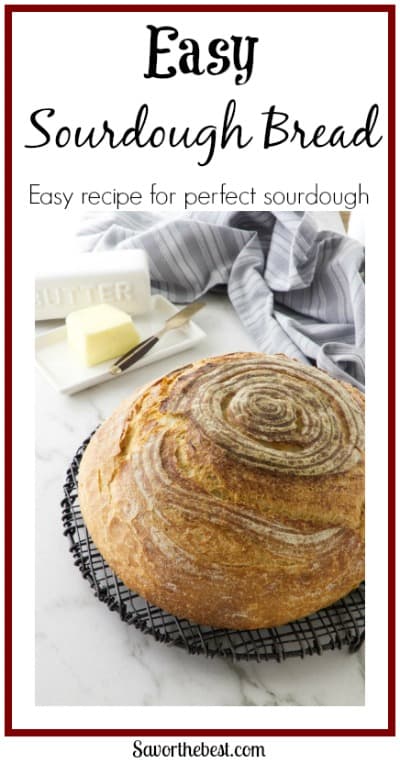

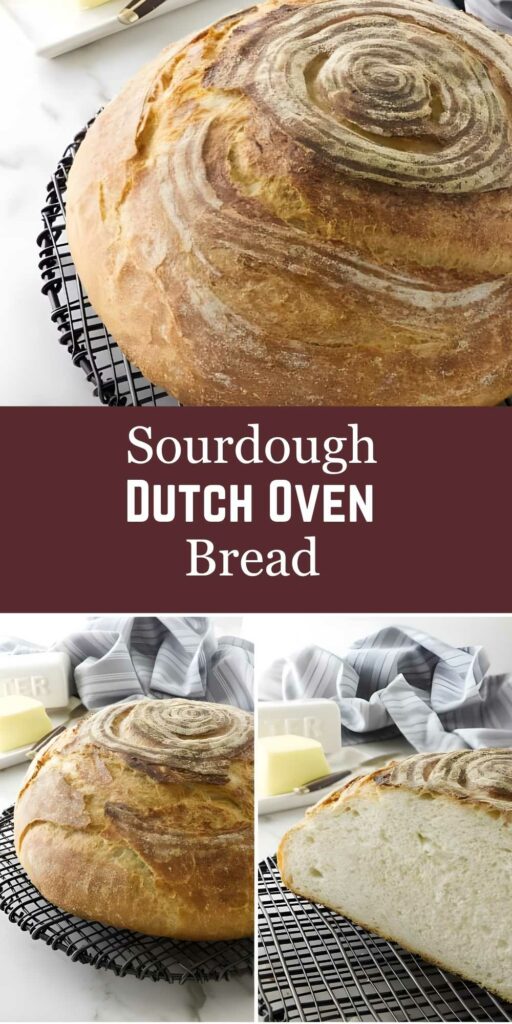
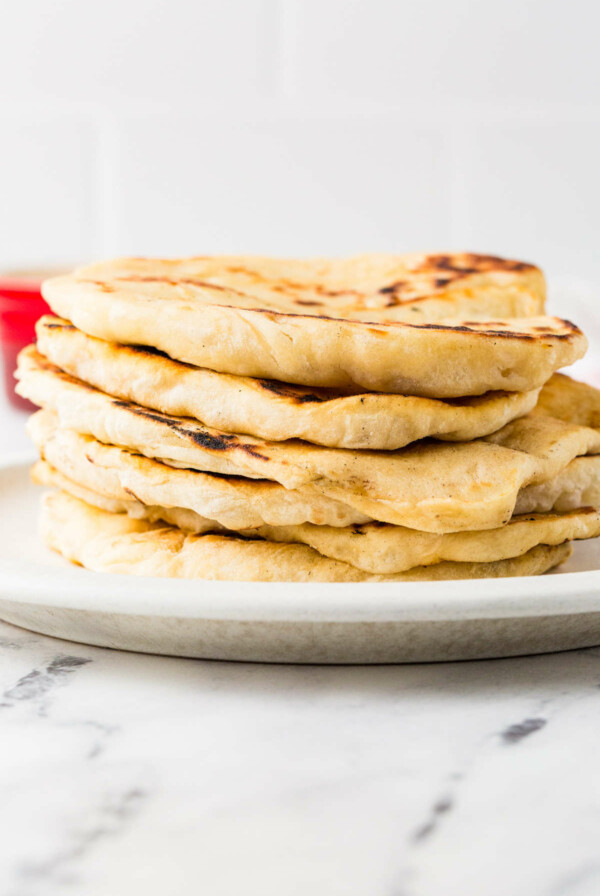
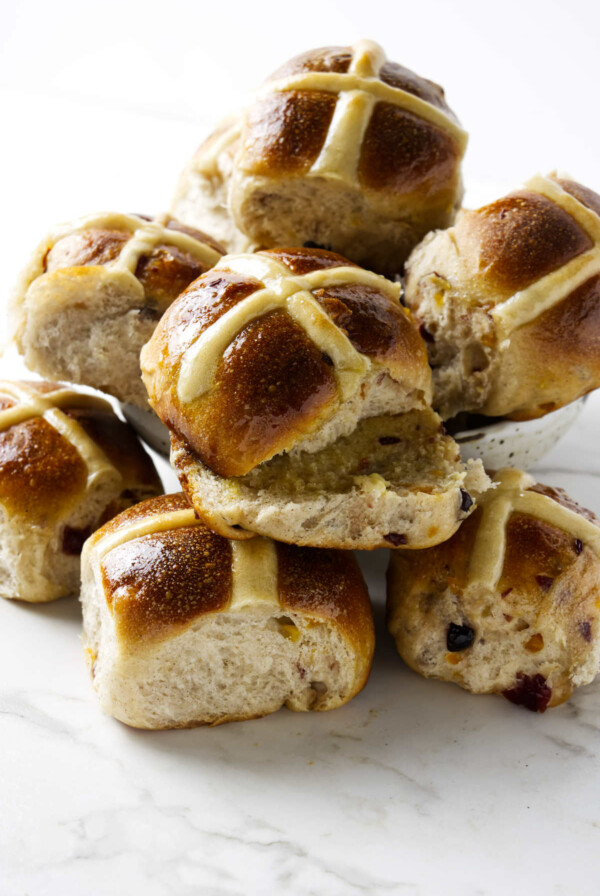
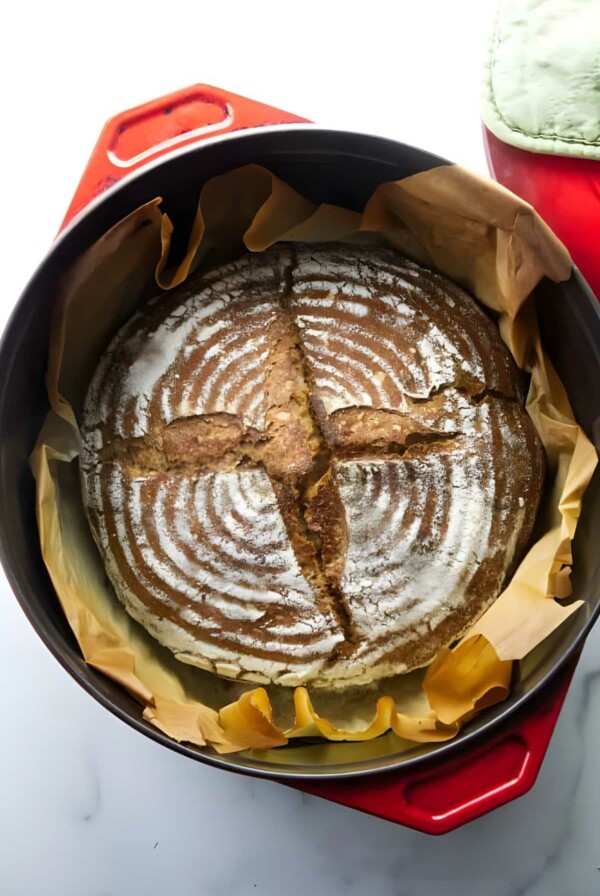
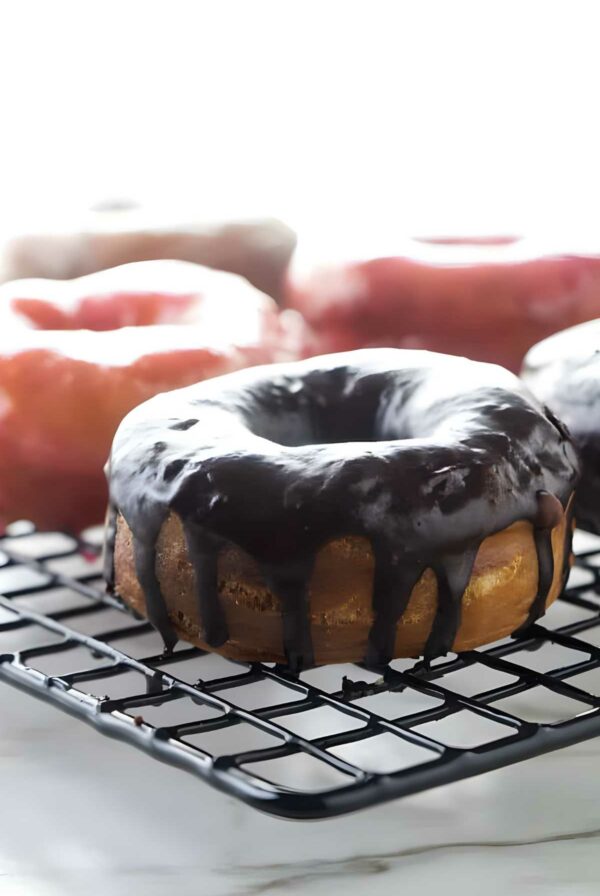










I have made this recipe several times with great success but always wanted the top crust as nice as the bottom crust (I use the preheated Dutch oven). So tonight I took the lid off after 30 minutes and it burned.
I might try it for the last 5 minutes next time or try a lower rack in the oven. Otherwise a perfect loaf!
Would love other troubleshooting ideas.
Thanks for a great recipe!
I would start with just changing one variable. For instance, either less time with the lid on OR moving it to a lower rack. That way you will know what worked/ didn’t work for your oven.
I’m thinking you would do well to try adjusting when you take the lid off since you already like how the bottom crust bakes.
Thanks for your comment, hope the next try goes well 😉
Thank you! Trying again this evening. 🙂
?
First time making sour dough bread and was very tasty and great texture! I added 20% rye flour The crust was super hard and dark and it’s possible because of oven. I am looking into getting light crust next time. Thank you!
I’m happy to hear it turned out on your first try. If you want a softer crust then coat the crust with butter as soon as it comes out of the oven. That will soften it up quite a bit
I had to call my daughter twice! She’s now the bread maker. I was a little confused when the notes came after I had some steps done. Would be easier if notes are with each step. This is our second recipe. We threw away the bread and the recipe. Yours in oven now.
Thank goodness for daughters!
I have made two loaves using this recipe now and both times, the dough was too wet to work with. I had to add quite a bit of flour while working it (it was just spreading like crazy).
Do you have any troubleshooting ideas? I am using 1:1:1 ratio to keep my mature and active starter fed…
Thanks!
How did they turn out when you added flour to them? If you are struggling to work with a wet dough it is ok to add enough flour so that it is easier to work with. Sometimes it takes some practice and experience to get the technique down. I would also check the type of flour you are using. Unbleached flour will work much better than bleached flour.
If I want to bake on Saturday, but won’t be home most of the day Friday. Can I mix up Thursday, do the first rise at room temp and then put in fridge until Saturday morning?
It is possible to let the bread proof that long in the fridge but results are a bit more unpredictable. Bread can still over-proof in the fridge. It is hard to know how it will behave with your particular starter and your particular fridge without trying it first. If you try it and find that it over-proofs then you might want to try doing both proofs in the fridge. Sometimes it takes a couple of trials to see how your starter responds to longer periods in the fridge.
What size Dutch oven is right for this recipe–I have a 7-1/4 quart Le Creuset and am wondering if it is too large, or if I could/should double the recipe?
A 6-1/2 to a 7-1/2 quart Dutch oven will work well for this recipe.
could I use this recipe for bread bowls? And if so would i just divide before proofing and change the baking time?
Yes that is exactly how you would do it. The bake time will depend a lot on how big the bread bowls are. To check for doneness, knock on the bottom of the bread bowls. If they sound hollow then they are done. If you want a less subjective way to tell if they are done then you can use an instant-read thermometer. This bread is finished baking when the center reads 190°F
When baking in a Dutch oven, do I use the lid? Also, my dough is very, very wet. I was so careful not to add too much flour, but I could never get my dough to form anything close to a ball. Should I have added more flour?
Yes, if you bake in a Dutch oven use a lid for the first 20 to 30 minutes then remove the lid and bake it the rest of the way. I will clarify that in the instructions, thanks. If your dough is too loose to form a ball then you may need to add a bit more flour. However, sometimes it is just a matter of getting the shaping process down. If you’re struggling then add more flour until you can shape it.
How would this work with whole wheat flour or another healthier alternative?
That works just fine. Whole wheat absorbs more water than white flour so you will want to increase the water a tad. Depending on your flour, you will need anywhere from 2 tablespoons to 1/3 cup more water. Just add the water a little at a time until the dough looks right. If you make 100% whole wheat bread then it will turn out denser and have less “spring” to the bread. Depending on what you are looking for, you may be disappointed. If you want a lighter, airier whole wheat then you could substitute 1/4 to 1/2 of the flour for whole wheat.
I also had trouble getting my dough TO BE sticky. It was far too dense and claggy. It’s been 12+ hours in the fridge and it’s a rock at this point. Would I be able to mix to water to my dough and keep going?
Yes, you can knead some water into the dough. If your dough is really dry it can take some time to knead it in but just be patient and work in a little at a time until you get the right consistency. Just go by look and feel, don’t worry that you seem to be using different ratios than the recipe. That is how bread making is sometimes because of the variables that can change the dough. If you’re new to breadmaking, watch the video to see what the dough should look like.